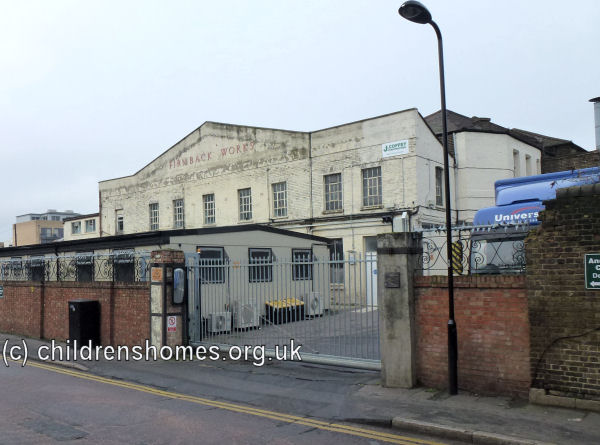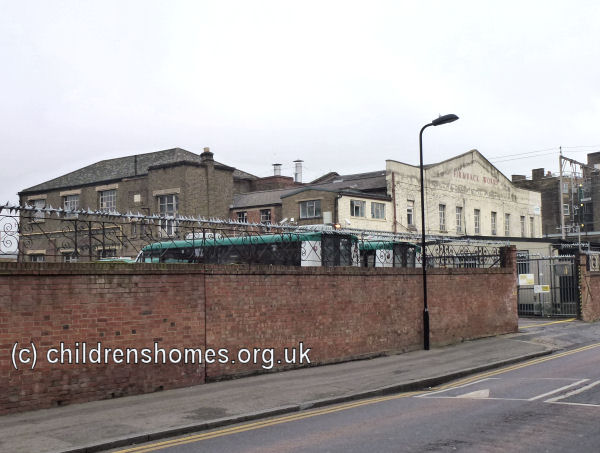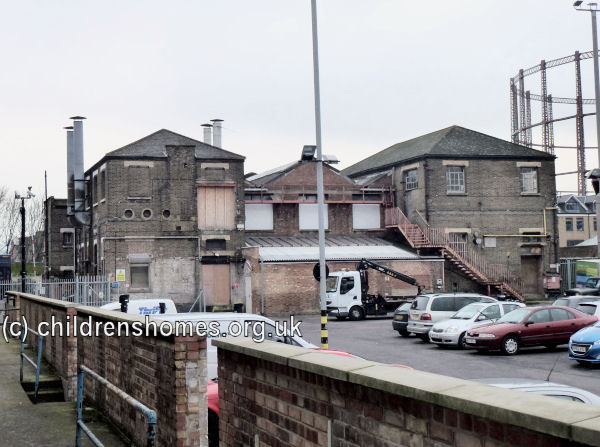King Edward Industrial School for Girls, Hackney, London
In 1875, the premises of the British Penitent Female Refuge at Andrews Road, Cambridge Heath, Hackney, were taken over as a Branch Home for the King Edward Industrial School for Girls at Mile End. The new establishment was formally certified for operation as Industrial School on January 21st, 1875.
During its first year of operation, major additions and alterations were made to the building, providing accommodation for 110 girls. Early in 1876, many of the older girls from the Mile End establishment were transferred to the new premises. A system was quickly adopted whereby Mile End received the younger girls, who were then transferred to Andrews Road at about the age of 10. In addition to girls committed by magistrates, a few children of 'vicious and criminal parents' were received free as voluntary cases. The superintendent was Miss Emma Dunkinson, who had previous been in charge of the Mile End establishment.

Former King Edward Industrial School, Hackney, 2013. © Peter Higginbotham

Former King Edward Industrial School, Hackney, 2013. © Peter Higginbotham

Former King Edward Industrial School, Hackney, 2013. © Peter Higginbotham
A report in 1876 described the location as far more open and healthy than the old school. The rooms as large and healthy, and there was plenty of space for exercise. There was a large schoolroom and good laundry. Further building in 1876 added a new wing and an additional schoolroom, followed in 1878 by another schoolroom, a dormitory, store rooms, work room, bath and dressing rooms, and teachers' apartments. The total capacity of the School was now 120 places. Eighteen of the older girls occupied their own dormitory which was separated into cubicles and fitted with with wash-hand stands.
In addition to classroom lessons, the girls were given training for domestic service. This included laundry work, needlework, and housework. By 1879, some of the older girls were receiving practical lessons in cookery. All the girls occasionally helped in the ordinary work of the house. A very complete outfit costing about £5 was given to each girl on leaving. The School made an annual contribution of £30 to the Metropolitan Association for Befriending Young Servants (MABYS) who provided hostels and other facilities to assist girls leaving Industrial Schools and taking up employment.
In 1881, Miss Dunkinson was succeeded as superintendent by Mrs Clarke. She, in turn, was replaced in 1885 by Miss Lyon.
In 1888, falling admissions at the Mile End School, said to be caused by its unsuitable location, led to a decision to close the establishment and transfer its operations to the Andrews Road site.
In 1891, Mrs Howarth took over as superintendent. The School now had a cottage at Southend to which girls who needed a change of air could be sent two or three at a time.
By 1896, the School was in the charge of Miss K. Russell. A report in that year noted that there was a spacious air about the interior, an open space in front where it faced the Regent's Canal, and a large garden at the hack, so that although situated in a crowded neighbourhood it was exceptionally well off for light and air. However, the presence of two timber yards in the vicinity necessitated special attention to guard against fire. In the classroom, geography and mental arithmetic were rated as 'very fair' and singing (sol-fa) was 'good'. There was praise for the effort being made to bring on older backward girls, and a kindergarten had been introduced for the little ones. The training for domestic service was described as 'ample', plenty of scope for housemaid's work, and special cookery lessons given by the assistant matron. Special lessons in dressmaking had recently been introduced and might open up a new source of employment for neat-handed girls. The laundry is well-fitted although the provision of a couple of small washing-machines would save a good deal of the rough work. The playground was ample and well fitted with swings. There was a large covered building in the centre which was especially useful in wet weather. A drill-instructor came once a week and put the girls through extension and marching exercises. There were small garden plots for some of the girls. From time to time small parties were been sent to the seaside for a change. Apart from Sundays, and when the girls were sent on errands, walks were only taken occasionally. Visits were paid from time to time to the Bethnal Green Museum, and treats of various kinds were arranged all through the year. The girls' health had been very good. The doctor visited once a week and as often as required, although did not conduct a quarterly examination. The dietary scale was said to be a liberal one and no doubt contributed to the excellence of the girl's health. Punishments were rarely administered. A mark system was in operation carrying monetary rewards for good conduct. There was also an 'honour' prize is awarded annually based on the girls' own votes. The School's committee took an active interest in the establishment and visited at least once a week.
In December, 1904, a girl at the School was kidnapped. It happened on a Sunday morning as the girls, in their grey gowns trimmed with red, were walking in pairs to attend the service at St Michael Church, London Fields. A man suddenly pounced on the girl and carried her off, apparently uncomplaining, to a trap which was waiting at the corner of Beck Street and Mare Street. The trap rapidly departed with the young woman inside. It was speculated that the girl had been abducted by friends, as it had been noticed for couple of Sundays previously that a strange man had been signalling in peculiar manner to one of the girls during the walk to church, but the teacher in change had never been able to make sure to which one. For the next three months, the girls were not allowed out at all. This was much to their great disappointment as the were unable to look at the Christmas things in the shops, and other seasonal events.
In 1912, the Middlesex County Council reported that corporal punishment had been prohibited at the School and that other methods had proved equally effective.
The School appears to have closed in around 1919. The building was subsequently used as a furniture factory known as the Firmback Works. The much altered premises are now a council car pound for illegally parked vehicles.
Records
Note: many repositories impose a closure period of up to 100 years for records identifying individuals. Before travelling a long distance, always check that the records you want to consult will be available.
- None identfied at present — any information welcome.
Census
Bibliography
- Higginbotham, Peter Children's Homes: A History of Institutional Care for Britain's Young (2017, Pen & Sword)
- Mahood, Linda Policing Gender, Class and Family: Britain, 1850-1940 (1995, Univeristy of Alberta Press)
- Prahms, Wendy Newcastle Ragged and Industrial School (2006, The History Press)
Links
- None noted at present.
Except where indicated, this page () © Peter Higginbotham. Contents may not be reproduced without permission.


